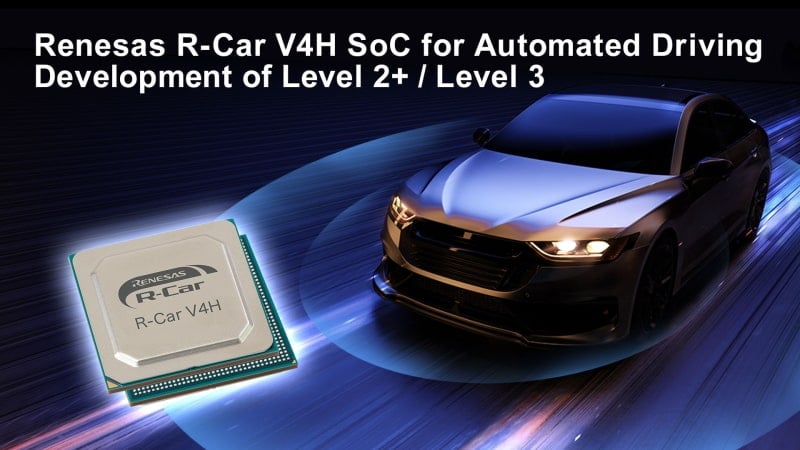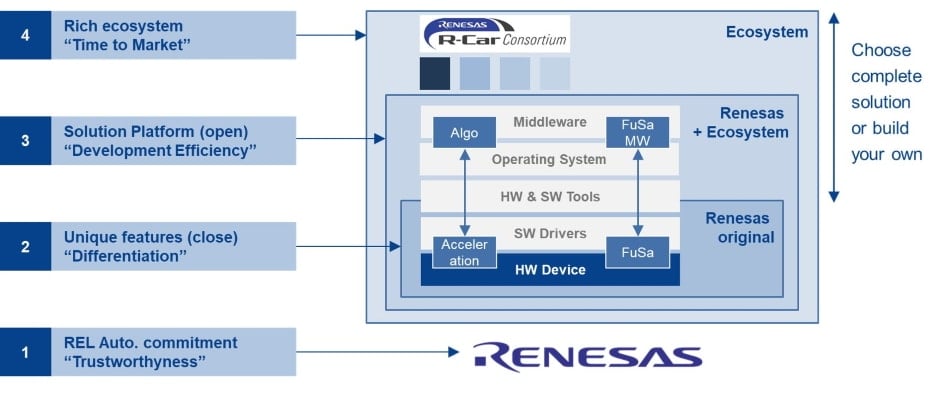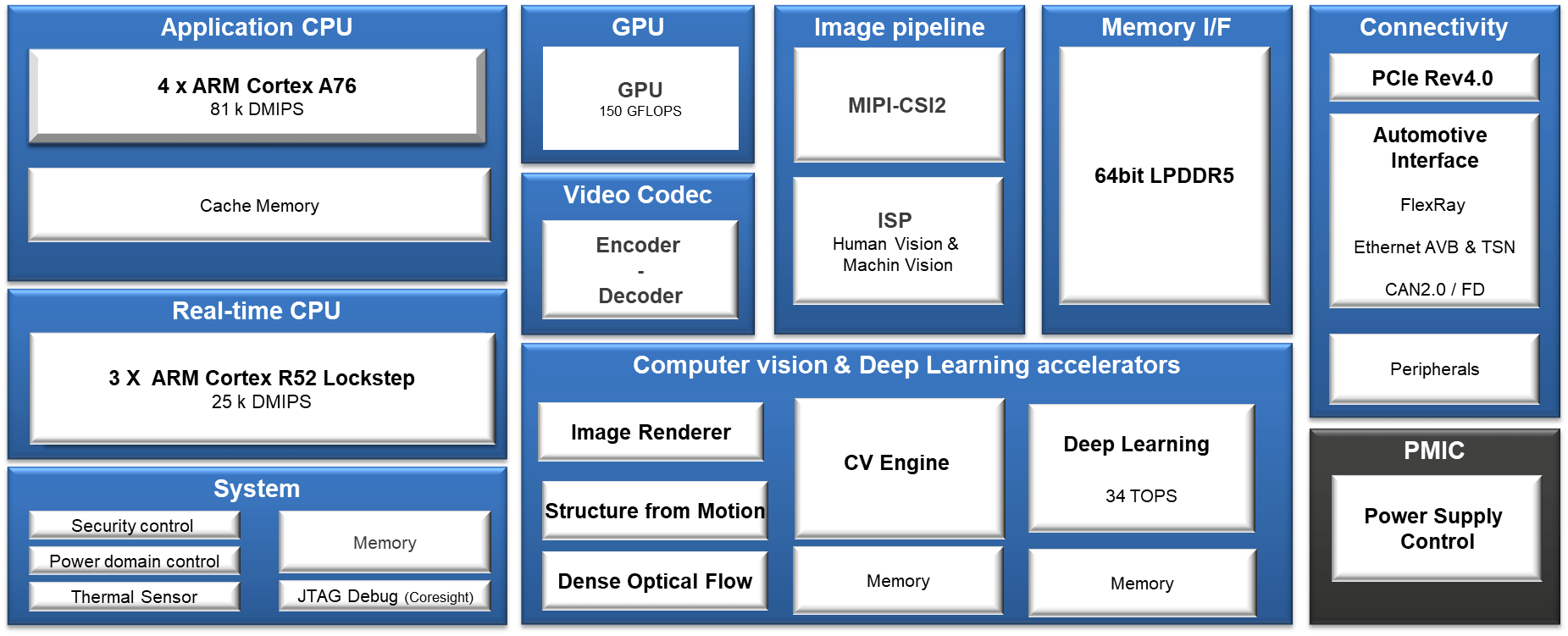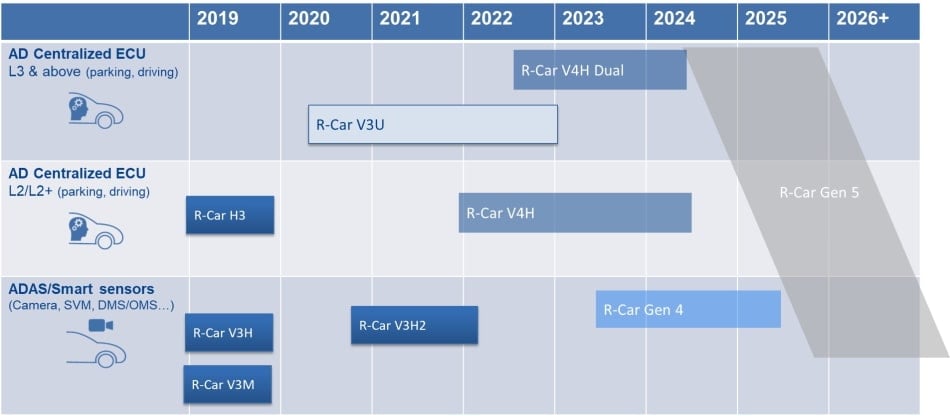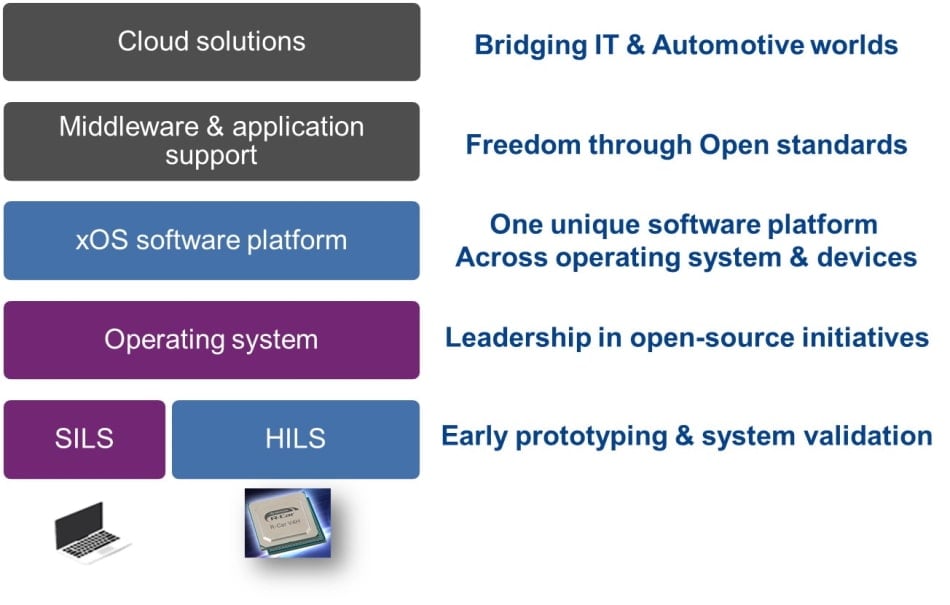Features
- Four Arm® Cortex®-A76 cores at 1.8GHz for a total of 81kDMIPS of general compute for ADAS/AD applications
- Three lockstep Arm® Cortex®-R52 cores at 1.4GHz, for a total of 25kDMIPS to support ASIL D real-time operation, and eliminate the need for external microcontrollers
- Dedicated Deep Learning and Computer Vision I/Ps with overall performance of 34 TOPS
- Image Signal Processor (ISP) with parallel processing for machine and human vision
- Image Renderer (IMR) for fisheye distortion correction or other mathematical operations
- Graphics Processing Unit (GPU) AXM-8-256 at 600MHz for a total of more than 150 GFLOPS
- Dedicated automotive Interfaces: CAN, Ethernet AVB, TSN, and FlexRay
- Two fourth-generation PCIe interfaces
- Integrates multiple safety mechanisms that provide high coverage with fast detection and response for random hardware faults, achieving ASIL B/D metrics for the majority of the SoC processing chain.
- Open solution supported by Renesas and R-Car Consortium partners
Description
Addressing volume zone of automotive driving Level 2+ / Level 3
The R-Car V4H system-on-chip is tailored for central processing for advanced driver-assistance (ADAS) and automated driving (AD) systems. The R-Car V4H achieves deep learning performance of up to 34 TOPS (Tera Operations Per Second), enabling high-speed image recognition and processing of surrounding objects by automotive cameras, radar, and Light Detection and Ranging (LiDAR).
Thanks to a high level of integration, the R-Car V4H allows manufacturers to develop cost-competitive, single-chip, ADAS electric control units (ECUs). These control units may support driving systems appropriate for automated driving Levels 2+ and Level 3, including full NCAP 2025 features. A dual V4H configuration enables seamless system performance improvements and fail-degraded operational support which is required for Level 3 systems. The R-Car V4H also supports surround view and automatic parking functions with impressive 3D visualization effects such as very realistic views.
In addition to R-Car V4H, discover our next cost-competitive product lineup (V4M) here.
R-Car V3M and R-Car V3H, both currently in high-volume production, focus on smart front cameras for Level 1 and Level 2 applications. R-Car V4H uses a scalable architecture that allows the re-use of software assets from the third generation of R-Car devices. This enables customers to expand to next-generation systems smoothly and quickly as they develop Level 2+ and Level 3 systems. The R-Car V4H also supports the latest LiDAR, radar, and thermal camera technologies.
State-of-the-art R-Car deep learning technology at low power consumption: 16 TOPS/Watt
The R-Car V4H offers up to 34 TOPS of highly efficient deep learning performance. It uses ultra-low power consumption and requires only passive air-cooling, both of which help reduce the total bill of materials (BOM).
Solution supports the industry’s stringent ASIL B/D requirements
The R-Car V4H development process targets ASIL D systematic capability for all safety-relevant IP. The signal processing portion of the R-Car V4H is expected to achieve ASIL B and D metrics for the real-time domain. Furthermore, the R-Car V4H can be used in combination with the RAA271041 pre-regulator and the RAA271005 PMIC optimized for cars. This enables a highly reliable power supply for the R-Car V4H and peripheral memories from the 12V supply of the vehicle battery. These features enable low-power operation while targeting ASIL D compliance for systematic and random hardware faults at a very low BOM cost. This helps to minimize the effort of hardware and software development while reducing design complexity, cost, and time to market. Superior scalability maximizes software re-use to cover ADAS/AD Level 1 to Level 3.
Embedded software platform development paving the way toward the software-defined car
An R-Car V4H Software Development Kit (SDK) is also available to perform faster and easier initial device evaluation and software development including deep learning. The SDK offers full functionality for machine learning development, and optimization of embedded systems for performance, power efficiency, and functional safety. Complete simulation models are available, and the Renesas operating system agnostic software platform enables easier development of the software-defined car.
Applications
- Automated Driving Level 2+, Level 3, Level 4
- Front Smart Camera for NCAP 2025 5 Stars
- Automatic Parking & Surround View with 3D Visualization
- Driver and Occupant Monitoring System
- Light Detection and Ranging (LiDAR) System
- Intelligent Survey Camera
- Robotics
- Industrial Applications
Applied Filters:
Filters
Software & Tools
Sample Code
Simulation Models
Introduction and guide on displaying trace data for each process and its time period within the specified capture address range in the "ETM Call Flow Trace" of e² studio for R-Car.
This video shows you how to set up a simple project to debug and monitor its memories using the RPM RAM I/O monitor feature in Real-time Performance Monitor view on e² studio for R-Car.
This video demonstrates how to execute and debug Linux applications running on R-Car using e² studio. It covers the program execution process and key debugging methods.
Chapter Titles
00:00 Opening
00:16 System structure
00:36 Connect target boards to e2 studio
00:54 Program execution and debugging methods
Related Resources
This video demonstrates how to debug Linux applications on R-Car with e2 studio. It covers system configuration, capturing runtime data, and performing performance analysis with LTTng.
Introduction and how to acquire trace data that records the status and execution time of each core in R-Car, and to display the acquired data in the DTA trace window using e² studio for R-Car.
This video shows how to build and debug a R-Car V4H project in Visual Studio Code (VS Code).
Related Resources
This video explains how to build a sample project with the R-Car SDK using e2 studio.
This video provides an Introduction and teaches how to measure the bus load inside an SoC using the Bus Monitoring Tool and display the data in e² studio.
Introduction and how to setup Real-time Performance Monitor view on e2 studio for R-Car.
This video shows how to connect target boards to e2 studio for debugging Linux applications running on the R-Car.
This video describes how to build a project and run a program in e² studio.
This video describes how to install and setup the GNU ARM Toolchain.
This video describes how to create a new project in e² studio.
This video describes how to install and setup e² studio for R-Car V4 Series SDK.
Renesas proves that R-Car V4H can realize a high-end surround-view system.
This video explains the following contents.
- R-Car Roadmap for ADAS/Automated Driving
- Surround-View System Introduction
- R-Car V4H Block Diagram
- PoC System Structure
- PoC video using the R-Car V4H
- Summary
Macronix is a leading Non-Volatile Memory solution provider.
R-Car system can realize fastboot through extreme I/O speed.
Winbond Electronics Corp. Japan
Secure FOTA Demo on AWS - R-Car M3 and W77Q Secure Flash
Introduction to our service for oscillation circuit
Apex.AI, Renesas, and SYSGO have joined forces to bring this solution for software-defined vehicles built upon Renesas R-Car SOCs.
R-Car V4H enables market-leading performance per watt through a careful combination of best-in-class IP and expert HW optimization. The new platform innovates by providing a cutting-edge development environment, paving the way to the software-defined car.
